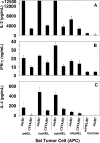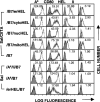MHC class II and CD80 tumor cell-based vaccines are potent activators of type 1 CD4+ T lymphocytes provided they do not coexpress invariant chain
- PMID: 14730400
- PMCID: PMC11032954
- DOI: 10.1007/s00262-003-0486-4
MHC class II and CD80 tumor cell-based vaccines are potent activators of type 1 CD4+ T lymphocytes provided they do not coexpress invariant chain
Abstract
We are developing vaccines that activate tumor-specific CD4+ T cells. The cell-based vaccines consist of MHC class I+ tumor cells that are genetically modified to express syngeneic MHC class II and costimulatory molecules. Previous studies demonstrated that treatment of mice with established tumors with these vaccines resulted in regression of solid tumors, reduction of metastatic disease, and increased survival time. Optimal vaccines will prime naïve T cells and activate T cells to tumor peptides derived from diverse subcellular compartments, since potential tumor antigens may reside in unique cellular locales. To determine if the MHC class II/costimulatory molecule vaccines fulfill these conditions, the vaccines have been tested for their ability to activate antigen-specific, naïve, transgenic CD4+ T lymphocytes. MHC class II(+)CD80+ vaccine cells were transfected with hen eggwhite lysozyme targeted to the cytosol, nuclei, mitochondria, or endoplasmic reticulum, and used as antigen-presenting cells to activate I-Ak-restricted, lysozyme-specific CD4+ 3A9 transgenic T cells. Regardless of the cellular location of lysozyme, the vaccines stimulated release of high levels of IFN-gamma and IL-2. If the vaccines coexpressed the MHC class II accessory molecule invariant chain, then IFN-gamma and IL-2 release was significantly reduced. These studies demonstrate that in the absence of invariant chain the MHC class II and CD80 tumor cell vaccines (1) function as antigen-presenting cells to activate naïve, tumor-specific CD4+ cells to endogenously synthesized tumor antigens; (2) polarize the activated CD4+ T cells toward a type 1 response; and (3) present epitopes derived from varied subcellular locales.
Figures





Similar articles
-
Activation of tumor-specific CD4(+) T lymphocytes by major histocompatibility complex class II tumor cell vaccines: a novel cell-based immunotherapy.Cancer Res. 2004 Mar 1;64(5):1867-74. doi: 10.1158/0008-5472.can-03-2634. Cancer Res. 2004. PMID: 14996751
-
Tumor-specific CD4+ T cells are activated by "cross-dressed" dendritic cells presenting peptide-MHC class II complexes acquired from cell-based cancer vaccines.J Immunol. 2006 Feb 1;176(3):1447-55. doi: 10.4049/jimmunol.176.3.1447. J Immunol. 2006. PMID: 16424172
-
Presentation of endogenously synthesized MHC class II-restricted epitopes by MHC class II cancer vaccines is independent of transporter associated with Ag processing and the proteasome.J Immunol. 2005 Feb 15;174(4):1811-9. doi: 10.4049/jimmunol.174.4.1811. J Immunol. 2005. PMID: 15699107
-
Cell-based vaccines for the stimulation of immunity to metastatic cancers.Immunol Rev. 1999 Aug;170:101-14. doi: 10.1111/j.1600-065x.1999.tb01332.x. Immunol Rev. 1999. PMID: 10566145 Review.
-
CD4+ T-cell activation for immunotherapy of malignancies using Ii-Key/MHC class II epitope hybrid vaccines.Vaccine. 2012 Apr 16;30(18):2805-10. doi: 10.1016/j.vaccine.2012.02.031. Epub 2012 Mar 3. Vaccine. 2012. PMID: 22386748 Review.
Cited by
-
Expression of costimulatory molecule CD80 in colonic dysplasia in ulcerative colitis: an immunosurveillance mechanism against colorectal cancer?Int J Colorectal Dis. 2006 Dec;21(8):776-83. doi: 10.1007/s00384-006-0095-8. Epub 2006 Mar 7. Int J Colorectal Dis. 2006. PMID: 16520930
-
Evaluation of an autologous cancer vaccine for the treatment of metastatic canine hemangiosarcoma: a preliminary study.BMC Vet Res. 2020 Nov 18;16(1):447. doi: 10.1186/s12917-020-02675-y. BMC Vet Res. 2020. PMID: 33208160 Free PMC article.
-
A Multigene Assay Determines Risk of Recurrence in Patients with Triple-Negative Breast Cancer.Cancer Res. 2019 Jul 1;79(13):3466-3478. doi: 10.1158/0008-5472.CAN-18-3014. Epub 2019 May 2. Cancer Res. 2019. PMID: 31048497 Free PMC article.
-
Invariant chain modulates HLA class II protein recycling and peptide presentation in nonprofessional antigen presenting cells.Cell Immunol. 2007 Sep;249(1):20-9. doi: 10.1016/j.cellimm.2007.10.005. Epub 2007 Dec 11. Cell Immunol. 2007. PMID: 18067883 Free PMC article.
References
-
- Armstrong Proc Natl Acad Sci U S A. 1997;120:123.
-
- Armstrong J Immunol. 1998;160:661. - PubMed
Publication types
MeSH terms
Substances
Grants and funding
LinkOut - more resources
Full Text Sources
Other Literature Sources
Research Materials

